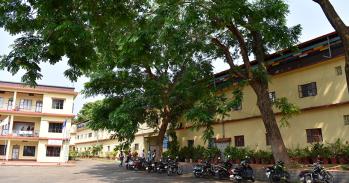
Ash dieback, caused by the Chalara fungus, prompts re-evaluation of current protocols to protect UK trees and other plants; taskforce recommends threats to plant health be taken as seriously as animal disease
Ash dieback, caused by the Chalara fungus, prompts re-evaluation of current protocols to protect UK trees and other plants; taskforce recommends threats to plant health be taken as seriously as animal disease
The UK needs to be better prepared for threats to plant health. In the last few years alone, several previously unknown pests and pathogens have emerged, posing significant risks to the UK’s crops as well as trees in woodlands, commercial forests and in urban environments.
Professor Chris Gilligan, chair of the taskforce and Professor of Mathematical Biology and Head of the School of Biological Sciences at the University of Cambridge
As the fungus responsible for ash dieback continues to devastate ash tree populations throughout the UK and other threats to the countryside continue to emerge, experts convened by Defra are advocating for stronger measures to protect the UK’s trees and plants.
The independent Tree Health and Plant Biosecurity Expert Taskforce was established by Defra’s Chief Scientific Adviser, Professor Ian Boyd, late last year to address the current and emerging threats to the UK’s trees and plants. Working with an advisory group made up of various stakeholder organisations, to include industry, Defra, and the Forestry Commission as well as Border Force, the taskforce is proposing a number of initiatives aimed at minimising the risk of plant pests and diseases.
Professor Chris Gilligan, chair of the taskforce and Professor of Mathematical Biology and Head of the School of Biological Sciences at the University of Cambridge, said: “The UK needs to be better prepared for threats to plant health. In the last few years alone, several previously unknown pests and pathogens have emerged, posing significant risks to the UK’s crops as well as trees in woodlands, commercial forests and in urban environments.
“By increasing our understanding of what pests and diseases are the biggest threats and how best to mitigate their impact, we can minimise potentially devastating outbreaks.”
The scientists believe that the threats have increased because of globalisation in trade and travel and the subsequent escalation in volume and diversity of plants and plant products entering the UK, all of which potentially harbour plant pests and pathogens. Once established, pests and pathogens can wreak havoc on biodiversity, timber and crop production, the landscape and, in certain circumstances, human health. (In addition to Chalara, recent examples include horse chestnut leaf mining moth, oak processionary moth, bleeding canker of horse chestnut and Dothistroma needle blight on pines.)
Professor Charles Godfray, a member of the taskforce from the University of Oxford’s Zoology Department & Oxford Martin School said: “Globalisation poses many challenges including to the health of our trees and other plants; the taskforce has tried to suggest proportionate measures that will materially lessen the risks to the nation’s trees and forests without adding unnecessary barriers to trade and commerce.”
Although the remit was to focus on trees and related woody species, the taskforce noted that many of the principles addressed in recommendations for tree health are applicable to pests and diseases that affect other plants (including agricultural, horticultural and biomass crops, indigenous vegetation and ornamental plants).
Taskforce recommendations
Currently, there are numerous risk assessments for individual pests and pathogens at both the national and European level. The taskforce recommends a single national Risk Register for plant health. This new UK Plant Health Risk Register would serve to identify and prioritise pests and pathogens that pose a threat to the UK and to identify what actions must be taken should the threat materialise.
The taskforce is also advocating an individual at a senior level who is responsible for overseeing the UK Plant Health Risk Register and providing leadership for managing those risks. The Chief Plant Health Officer would work in a similar fashion as the Chief Veterinary Officer, who oversees animal-related emergencies.
The appointee would also be responsible for developing and implementing procedures for preparedness and contingency planning to predict, monitor and control the spread of pests and pathogens. There was also a recommendation that current governance and legislation needed to be reviewed, simplified and strengthened.
Because of globalisation, more and more people and goods are travelling greater distances at an increasingly greater rate. As a result, there is a significant increase in the risk of introducing non-native pests and pathogens. In order to minimise the risks of introduction at the border, the taskforce has made several recommendations regarding the import of trees and other plants. They propose that no plant material for personal use be imported from outside the EU.
The import of live plants, foliage, branches and other plant parts has seen a 71 per cent increase since 1999, dramatically increasing the risk a pathogen or pest might be introduced. Therefore they also propose the Plant Passport scheme, which currently only applies to some plants associated with pests and pathogens, be strengthened and also applied to seeds as a means of ensuring traceability (showing all ports of calls within the EU and last port before entry to the EU).
Dr Jens-Georg Unger, taskforce member and Head of the Institute for National and International Plant Health in Germany, said: “There have been too many introductions of serious new pests in recent years into EU countries - improvements are needed urgently. Efficient protection can only be achieved by more complete and faster exchange of information between countries and more focussed and better coordinated action in all EU countries. The UK taskforce is an extremely important step for the initiation of such improvements on the national and the EU level.”
Additional recommendations include improving the use of epidemiological intelligence from EU/other regions and work to improve the EU regulations concerned with tree health and plant biosecurity, developing a modern, user-friendly, system to provide quick and intelligent access to information about tree health and plant biosecurity, and addressing key skills shortages.
For more information about this story, please contact: Genevieve Maul, Office of Communications, University of Cambridge. Email: Genevieve.Maul@admin.cam.ac.uk; Tel: 01223 765542.
This work is licensed under a Creative Commons Licence. If you use this content on your site please link back to this page.





